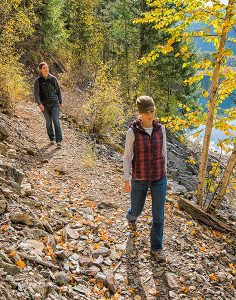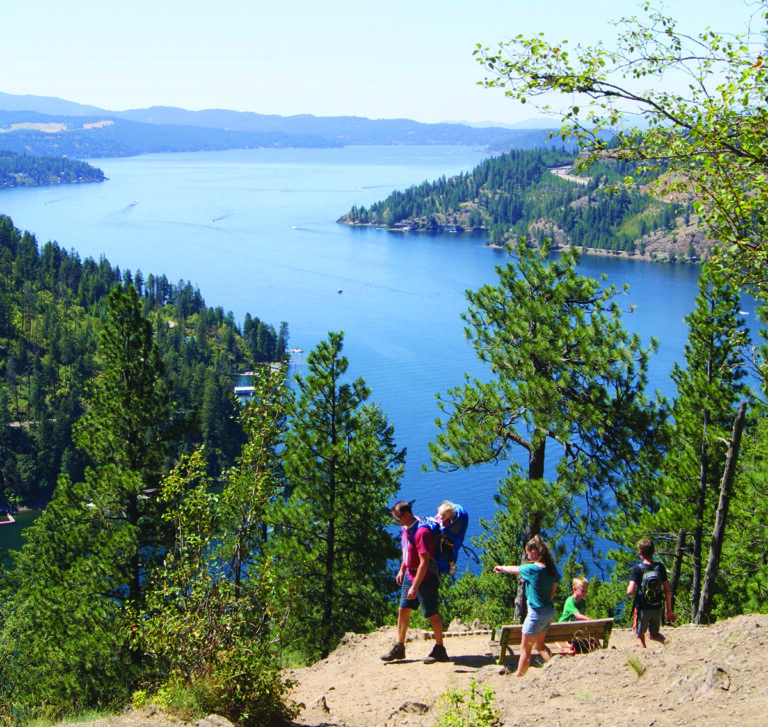I arrived at the trailhead to St. Leon Hot Springs, in British Columbia’s Arrow Lakes Valley – unsigned and accessed by a rough logging road, like many such Canadian destinations – just as a local painter and her guests were leaving. Soliciting suggestions for camping nearby, I ruled out their previous night’s accommodations, wherein they simply dozed in the hot springs all night. “Why don’t you camp in my yard?” offered the painter. So that night, on the wide, slow-moving banks of the Slocan River, I dined on vegan cuisine and wine with a painter, her dog, a couple who were road-tripping from Toronto to Seattle, and a guy living in a van on the property. It was the kind of real, memorable experience that you can only have in friendly, off-the-beaten path places. The kind of places that make up much of the route along the Selkirk Loop.
The continent’s only international scenic byway, the Selkirk International Scenic Loop winds 280 miles through Washington, Idaho and southern British Columbia. From Sandpoint, the Selkirk Loop passes through the Kootenai River Valley, its broad, fertile farmland flanked by the Idaho Selkirks to the west and the Purcells to the east. North of the international border, the route traces the upturned-boot shape of the east shore of Kootenay Lake, crossing the lake on the world’s longest free ferry before proceeding to the artsy, outdoorsy community of Nelson. From there, a quiet highway winds south through the Salmo River Valley and across the border to Metaline Falls, paralleling the north-flowing Pend Oreille River among lily pad-bedecked ponds and the pine-dotted foothills of exposed rock that comprise the southernmost Selkirks back into Idaho. Six side trips add another 450 miles of pavement.
The fjord-like lakes and fog-enshrouded peaks comprising the Selkirk Loop, more than other places, have been shaped by ancient but restive geological forces: some of the continent’s oldest rock; deep, glacier- and flood-gouged lakes; vast veins of ore; hidden geothermal hot springs. The dramatic landscape belies a lightly traveled, well-paved road system that attracts road-trippers from around the world. Wildlife-watchers can scout for bighorn sheep, mountain goats and birds, and history buffs can tour the many interpretive sites showcasing the region’s pioneer history. All will admire the sky-scraping Selkirks mirrored in the myriad lakes and rivers on the loop. Travelers can enjoy the Selkirk Loop year-round, but autumn boasts particular delights, with the golden glow of western larch providing one of the Northwest’s best fall flora shows.

And the same landscape that inspires visitors inspires artisans in funky communities from Boswell to Winlaw; Nelson is ranked the number-one small arts town in Canada, and signs for ceramists’ and seamstress’ studios line the loop. Tourists should consider saving trunk space for artwork that they might find on the loop. Crawford Bay, on the east shore of Kootenay Lake, in particular, is famed for its handmade wooden brooms. There’s an open-air mysticism here, a mix of hardcore mountain-living and hippie, that’s represented in events from Renaissance faires to rave-music festivals; travelers should check an event calendar to catch Selkirks culture at its peak.
The International Selkirk Loop website has sample itineraries that break the loop into logical, manageable chunks. But there’s an appeal to an open-ended itinerary, the vast landscape of the Selkirks ideally suited to the languid pace of vacation. And the intersection of mountain and river, dramatic and serene, makes for a mix of activities, from relaxed – a sunrise stand-up paddleboarding session on Kootenay Lake, plentiful berry-picking in the Salmo River valley – to more hardcore, with some of the world’s most-intense mountain biking and backcountry skiing deep in the forests and steep pinnacles of the mountains, particularly on the Canadian side.
Tent campers will find some of the finest public-lands camping in the region among the numerous provincial parks and national forest campgrounds, including Kokanee Creek Provincial Park east of Nelson, Crawford Bay Provincial Park on Kootenay Lake, and Sullivan Lake near Metaline Falls.
Travelers who prefer plusher accommodations can find lodging listings on the Selkirk Loop website. Sandpoint and Nelson, British Columbia, the largest communities on the Loop, both have plentiful accommodations and clean, quiet and safe campgrounds. Both towns are suggested overnight stops for all travelers. A bohemian enclave in the Kootenays, Nelson has a lively nightlife scene and dining to accommodate every appetite, from vegan to carnivore. Here and in Sandpoint, tourists will find good coffee shops and all-important free wi-fi. More importantly, both towns have thriving craft-beer scenes.
To plan a trip along the Selkirk Loop, which is most often completed as a vehicle road trip but is also gaining popularity among bicycle tourers, visit the International Selkirk Loop website at Selkirkloop.org. //












